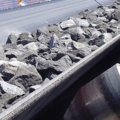Power generation with solar thermal power plants bring significant advantages for energy storage
Ceramic particles are used as heat storage and the efficiency for power generation can be determined, via non-contact layer thickness measurement.
Solar thermal power plants (CSP plants = Concentrating Solar Power plants) have so far been a rather exotic technology for generating high energy densities. They represent a technology that is not yet widespread and whose importance for the climate-neutral transformation of the global energy system is often underestimated. (Article: “New DLR-Solar-Tower“)
Problem: Fluctuations in energy yield from wind generators and photovoltaics
For the fluctuations in energy output from wind generators and photovoltaics, there are currently no efficient solutions for storing large amounts of electricity to compensate for these fluctuations.
New solution approach: solar thermal power plants as a supplement
Solar thermal power plants store heat instead of electricity. This approach has the advantage of being 80 to 90 percent cheaper, as these power plants can generate solar power even when the sun is not shining.
Growing shares of fluctuating feed-in from renewable energy sources such as photovoltaics and wind into the power grids make it necessary to supplement this with controllable power plants so that the exact amount of electricity currently demanded can be provided.
In sunny countries, solar thermal power plants are suitable for filling the gap of wind lulls or darkness, as they can produce electricity at any time with their heat storage. Solar thermal power plants can replace fossil fuel power plants in their role as base load and peak load power plants. For example, small CSP plants can be economically interesting for the direct power supply of industrial areas if the industrial customers also purchase process heat in addition to electricity, e.g. from steel production and the chemical industry.
Advantages of solar thermal power plants in electricity generation
At first glance, the conversion of solar radiation first into thermal energy and then into electrical energy seems somewhat cumbersome compared to electricity generation with solar cells. The generation of thermal energy is exactly the advantage of solar thermal power plants:
- Heat is easier and cheaper to store than electricity
- With this solar energy stored in the heat, can also be used in the darkness, electricity can still be generated.
How does the principle of solar thermal power plants work?
A solar thermal operates similarly to a conventional steam power plant, using concentrated solar radiation as fuel. To achieve the high temperatures required for steam generation, the solar radiation must be concentrated. Mirrors placed nearby are used to concentrate the sunlight. A heat storage system allows the energy fluctuations to be balanced over the course of the day.
Liquid salt, for example, has been used to date as the medium that absorbs the thermal energy. However, this process has certain disadvantages in terms of the efficiency of the heat storage capability.
Innovative use of ceramic particles for heat storage
Instead of liquid salt, ceramic particles are used as a heat transfer medium. They are inexpensive to produce and have a high heat storage capacity.
The ceramic particles can absorb temperatures up to 600 °C higher than previously possible in solar thermal power plants. This increases the efficiency of the conversion of solar radiation into electricity. The power plant can therefore generate more electricity from the same collector area, making it more efficient.
The German Aerospace Center (Deutsches Zentrum für Luft- und Raumfahrt e. V., DLR) develops and tests components and processes for the use of suitable new heat transfer and storage media together with various industrial partners.
DLR uses the Q6 laser scanner from QuellTech to measure the thickness of the heat carrier layer in the rotating drum. In a separate measurement process, the empty drum is recorded as a 3D point cloud. This point cloud is then compared with the point cloud of the filled ceramic substrate. https://www.dlr.de/en
As a result, layer thickness point cloud can be evaluated. With this procedure a uniform filling and layer thickness of the ceramic particles in the drum is achieved.
Measurement of the drums in practice with the non-contact 3D laser scanner measuring system from QuellTech
The drum rotates at high speed to exert a centrifugal force on the ceramic particles, preventing the particles from falling off the drum surface. With the QuellTech Q6 laser scanner and the available image processing software, an “area of interest tracking mode” is activated to better measure the surface.
The ceramic particles are relatively dark, requiring some exposure time to make them visible. Despite these challenges, nearly 2kHz (profiles per second) of speed was achieved.
QuellTech optimized the laser scanner settings for DLR’s measurement setup and implemented a software program that could be quickly adapted to user requirements by leveraging our proven image processing platform. This approach allows projects to be implemented much faster. For example, in this project, our proven algorithms were used to compare two different 3D point clouds and to connect horizontal 3D point cloud strips.
In order to compare an empty drum to a drum with particles and to see the influence of the particles on the thickness, it is important to have the same starts and ends when comparing two different point cloud data. To do this, we used a signal from rotary encoders when each rotation ended. This signal helped to define the limits of a single rotation and to compare two point clouds accurately.
Advantages of the QuellTech solution
3D display provides overview of the entire drum
- In principle, the Q6 laser scanner can only capture a specific part of the drum. However, it was possible to connect horizontally via a 360° strip to obtain an overview of the entire drum.
Continuous check of the required circularity in the measuring process
- With the QuellTech Q6 laser scanners, DLR can additionally analyse the circularity of the drum rotation in this energy project.
Quality assurance through early alarm
- If there are irregularities in the circularity, these become visible as ripples on the point cloud data, which can then be compensated for with fine mechanical adjustments.
You are currently viewing a placeholder content from Facebook. To access the actual content, click the button below. Please note that doing so will share data with third-party providers.
More Information





 QuellTech GmbH
QuellTech GmbH Conveyor belt
Conveyor belt